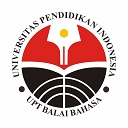Project Based Learning (PBL) Implementation for Improving Japanese Language Grammar Competence in Virtual Classroom
Abstract
This study aims to determine the implementation and improvement of learning outcomes in the virtual classroom method through Project Based Learning (PBL) method on learning Japanese grammar. The application of PBL in virtual classrooms is an alternative for active learning. Virtual classroom is one form of learning space that applies the use of current technology to shorten and eliminate distance and space, where learning is able to be carried out through social media. PBL itself emphasizes the learner’s ability to apply learning into daily life through certain projects. This study uses a quasi-experimental method. The sample or data source of this research was students in semester 3 of the Japanese Language Education Study Program at one of the private universities in Jakarta. Based on the Mann Whitney test using SPSS 25, the sig value was 0.001. Because the value of sig = 0,000 <0.005, there is a significant difference between the pre-test and post-test values between before and after the application of the virtual classroom method through PBL. Based on the results of the gain in pre-test and post-test values, the result was 17%. So it can be concluded that PBL implementation in the virtual classroom cannot increase the value of learning outcomes in learning Japanese grammar.
Keywords
Full Text:
PDF (ENG)References
Istianingrum, A., & Karnawati, R. A. (2020). Efektivitas virtual classroom dan flip the teacher dalam flipped classroom pada chuukyuu pola kalimat. Journal of Japanese Language Education and Linguistics, 4(2), 115–131.
Kristanti, Y. D., Subiki, S. & Handayani, R. D. (2016). Model pembelajaran berbasis proyek (Project based learning model) pada pembelajaran. Jurnal Pembelajaran Fisika, 5(2), 122–128. Retrieved from https://jurnal.unej.ac.id/index.php/JPF/article/view/3958.
Made, N., Suranti, Y., & Sahidu, H. (2016). Pengaruh model project based learning berbantuan media virtual terhadap penguasaan konsep peserta didik pada materi alat-alat optik. Jurnal Pendidikan Fisika dan Teknologi, 2(2), 73–79. http://dx.doi.org/10.29303/jpft.v2i2.292
Nurfitriyanti, M. (2016). Model pembelajaran Project Based Learning terhadap kemampuan pemecahan masalah matematika. Formatif: Jurnal Ilmiah Pendidikan MIPA, 6(2), 149–160. https://doi.org/10.30998/formatif.v6i2.950
Rochmah, E., & Abdul Majid, N. W. (2018). Membangun virtual classroom melalui Social Learning Networks (SLNS). Premiere Educandum : Jurnal Pendidikan Dasar Dan Pembelajaran, 8(1), 15. https://doi.org/10.25273/pe.v8i1.1832
Sohibun, S., & Ade, F. Y. (2017). Pengembangan media pembelajaran berbasis virtual class berbantuan Google drive. Tadris: Jurnal Keguruan Dan Ilmu Tarbiyah, 2(2), 121. https://doi.org/10.24042/tadris.v2i2.2177
Hernáiz-Pérez, M. et al. (2021). Contextualized project-based learning for training chemical engineers in graphic expression. Education for Chemical Engineers, 34, 57–67. https://doi.org/10.1016/j.ece.2020.11.003
Hiroyuki, S. (2014). Gaikoku Jin No Tame No Jitsuyou Nihongo Bunpou. Tokyo: Suri-enettowa-ku.
Kaushik, M. (2020). Evaluating a first-year engineering course for Project Based Learning (PBL) essentials. Procedia Computer Science, 172(2019), 364–69. https://doi.org/10.1016/j.procs.2020.05.056
DOI: https://doi.org/10.17509/japanedu.v6i1.29746
Refbacks
- There are currently no refbacks.
Copyright (c) 2021 JAPANEDU: Jurnal Pendidikan dan Pengajaran Bahasa Jepang

This work is licensed under a Creative Commons Attribution-ShareAlike 4.0 International License.
 Published by:
Published by: Department of Japanese Language Education, Faculty of Language and Literature Education
Universitas Pendidikan Indonesia
 Online ISSN: Online ISSN:2528-5548 |

JAPANEDU: Jurnal Pendidikan dan Pengajaran Bahasa Jepang (e-ISSN:2528-5548) lisenced under a Creative Commons Attribution-ShareAlike 4.0 Internasional (CC BY-SA 4.0)

